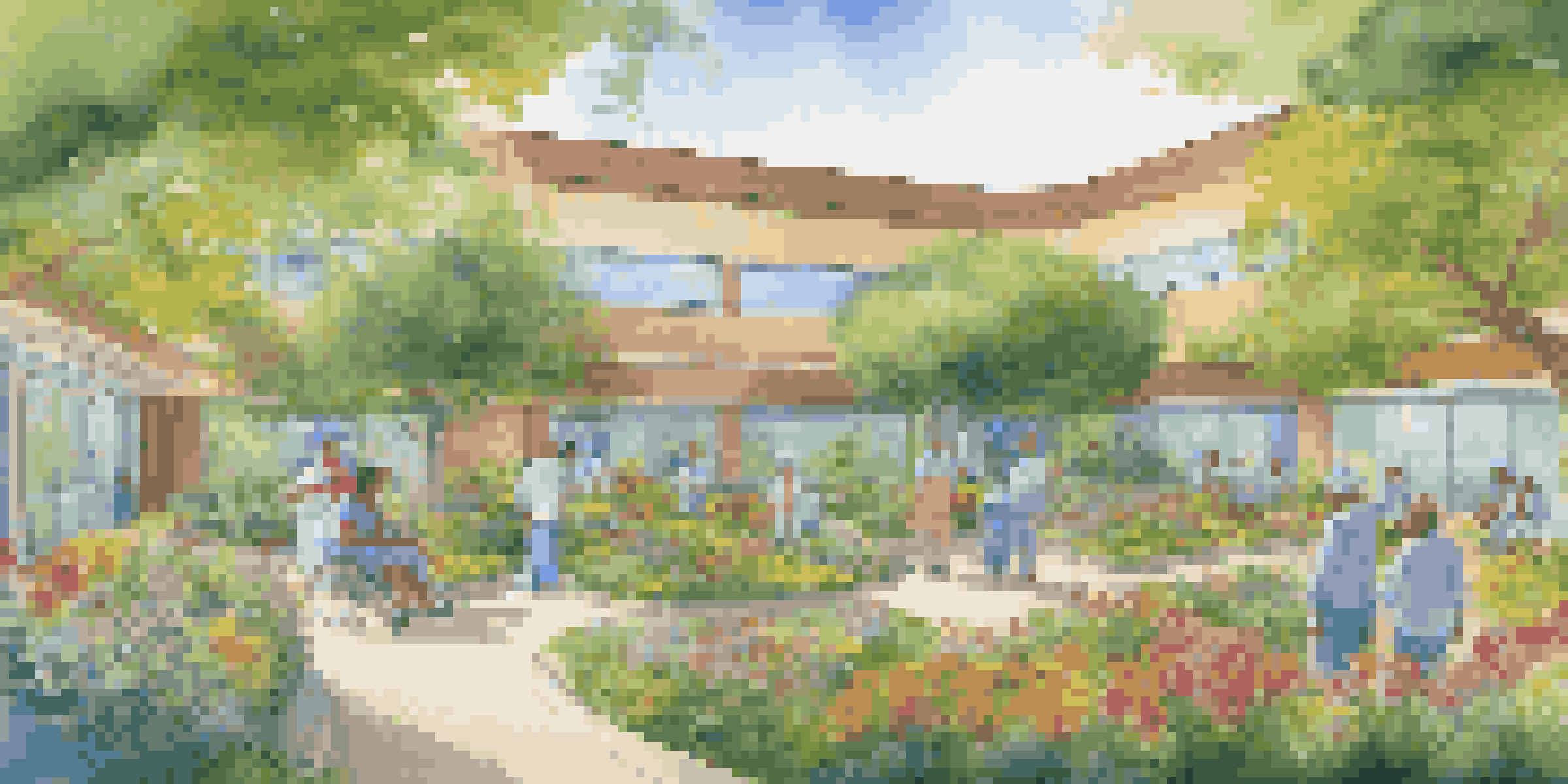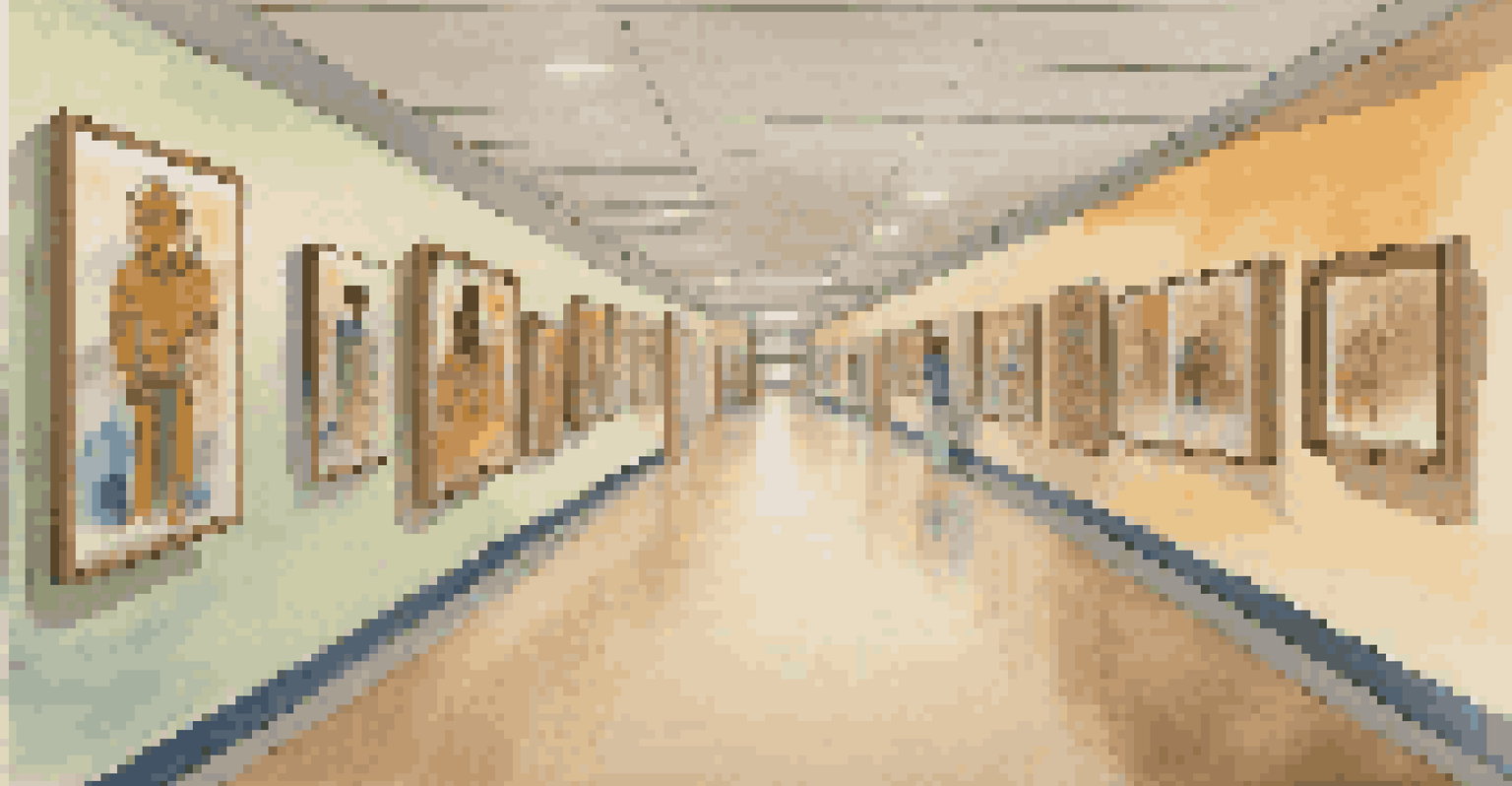The Role of Art in Fostering Community in Hospitals

Understanding the Healing Power of Art
Art has long been recognized for its ability to heal and inspire. In hospital environments, art serves a vital role by providing comfort and distraction to patients facing difficult circumstances. This connection to creativity not only uplifts spirits but also fosters a sense of hope and resilience.
Art enables us to find ourselves and lose ourselves at the same time.
When patients encounter art, whether it’s through paintings on the walls or sculptures in a garden, they are often transported to a different mental space. This shift can alleviate stress and anxiety, making a significant difference in their overall experience. For instance, a vibrant mural might evoke cheerful memories, momentarily easing the burden of their health challenges.
Moreover, engaging with art can stimulate cognitive functions, promoting healing in both mind and body. As patients become immersed in artistic expressions, they may find renewed motivation to engage with their recovery journey, highlighting the integral role of creativity in healthcare.
Creating Connections Through Collaborative Art Projects
Collaborative art projects in hospitals offer patients, families, and staff an opportunity to bond over shared experiences. These projects can take many forms, such as mural painting or community art installations, encouraging teamwork and communication among participants. This collaboration fosters a sense of belonging, which is crucial in a hospital setting.

For example, a local artist may lead a workshop where patients and their families create a collective piece of art. This not only results in a beautiful creation but also opens up conversations and helps participants share their stories. Such interactions can bridge the gap between individuals facing similar struggles, creating a supportive community.
Art Promotes Healing and Comfort
Art enhances the healing process by providing comfort, reducing anxiety, and uplifting spirits in hospital settings.
The process of creating art together can also be therapeutic. By collaborating, participants may express feelings that are hard to articulate, leading to emotional healing and support. Ultimately, these projects enhance the hospital environment by transforming sterile spaces into vibrant, welcoming areas filled with personal stories.
Art as a Tool for Patient Expression and Empowerment
Art provides a powerful outlet for patients to express their emotions and experiences. For many, the hospital can feel isolating, and art becomes a means to communicate thoughts that might be difficult to share verbally. It empowers them to convey their journey, facilitating a deeper understanding of their feelings.
Every artist dips his brush in his own soul, and paints his own nature into his pictures.
For instance, expressive art therapy sessions allow patients to use various media, such as painting or sculpture, to depict their personal narratives. This process can be liberating, granting them agency over their stories and promoting self-reflection. Through their art, patients often discover new insights about themselves and their healing journey.
Additionally, showcasing this artwork within the hospital can help raise awareness about patient experiences. When staff and visitors engage with these pieces, it can foster empathy and understanding, ultimately creating a more compassionate healthcare environment.
Enhancing Hospital Environments with Art Installations
Art installations in hospitals can transform sterile, clinical spaces into warm, inviting environments. Thoughtfully selected artwork can create a calming atmosphere, reducing anxiety for patients and their families. For example, nature-themed pieces can evoke a sense of tranquility, helping to create a more pleasant experience during stressful times.
Hospitals that integrate art into their design often report improved patient satisfaction. When patients feel more comfortable and relaxed, they may experience shorter recovery times and better health outcomes. This highlights the importance of considering aesthetic elements as part of patient care.
Collaboration Builds Community
Collaborative art projects foster connections among patients, families, and staff, creating a supportive environment in hospitals.
Moreover, engaging local artists to contribute can foster community pride and involvement. When local talent is showcased, it not only beautifies the space but also strengthens the bond between the hospital and the community it serves.
Art Programs for Staff Wellbeing and Team Building
Art isn’t just beneficial for patients; it also plays a significant role in staff wellbeing. Healthcare workers face immense pressure and burnout, and engaging in creative activities can serve as a much-needed outlet for stress relief. Participating in art programs can help staff recharge and maintain their passion for patient care.
Workshops that encourage staff to create art together can enhance teamwork and communication. As colleagues collaborate on creative projects, they build stronger relationships, which can translate to improved cooperation in patient care. These bonds can foster a more positive work environment, benefiting both staff and patients alike.
Additionally, art can serve as a reminder of the joy and beauty inherent in the healing process. By rekindling their creativity, healthcare workers can bring renewed energy and compassion to their roles, ultimately enriching the hospital community.
Cultural Representation: Art in Diverse Hospital Settings
Incorporating diverse artistic expressions is essential in creating an inclusive hospital environment. Art can reflect the cultural backgrounds of patients, fostering a sense of belonging and understanding. When individuals see their culture represented in the hospital, it can enhance their comfort and connection to the space.
For example, a hospital that features artwork from various cultural traditions can make all patients feel valued and represented. This not only enriches the hospital's aesthetic but also opens dialogue about different cultural experiences and perspectives, nurturing a more empathetic community.
Cultural Representation Matters
Incorporating diverse artistic expressions in hospitals fosters a sense of belonging and enhances patient comfort and connection.
Moreover, art can be a bridge to cultural healing practices. By acknowledging and integrating these practices into the hospital environment, healthcare providers can enhance the overall patient experience, making care more holistic and personalized.
The Future of Art in Healthcare: Innovations and Trends
As we look to the future, the role of art in healthcare continues to evolve with innovative approaches. Technology, for example, is paving the way for immersive art experiences, such as virtual reality art therapy, which can transport patients to serene environments or allow them to create art in a digital space. These advancements can broaden access to artistic expression for those unable to participate in traditional methods.
Additionally, hospitals are increasingly recognizing the importance of art in patient-centered care, leading to more structured art programs and collaborations with artists. This trend is encouraging a deeper commitment to integrating art into the healthcare experience, ultimately enhancing patient wellbeing.

As the conversation around art and health continues to grow, we can expect more hospitals to embrace these creative initiatives. By prioritizing artistic expression, healthcare facilities can foster stronger communities that promote healing for everyone involved.